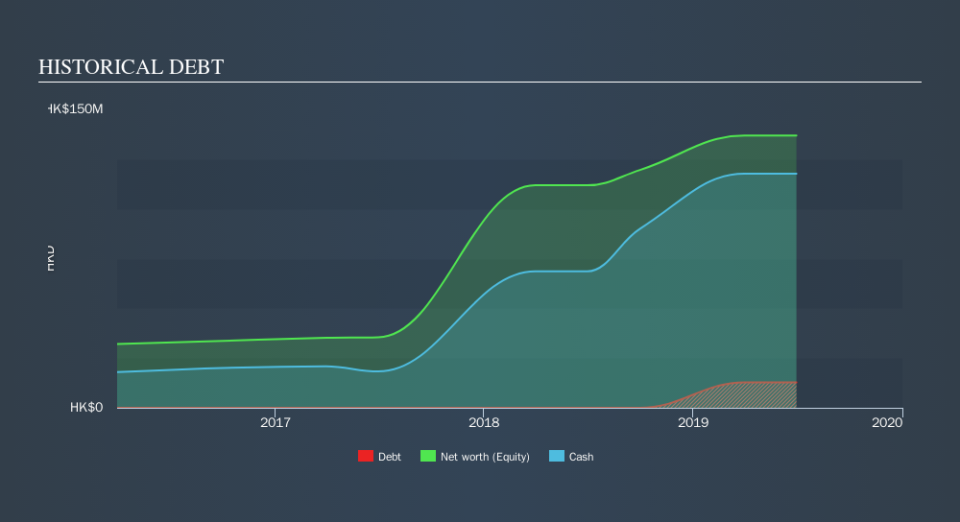Sanbase (HKG:8501) Could Easily Take On More Debt

Legendary fund manager Li Lu (who Charlie Munger backed) once said, 'The biggest investment risk is not the volatility of prices, but whether you will suffer a permanent loss of capital. It's only natural to consider a company's balance sheet when you examine how risky it is, since debt is often involved when a business collapses. As with many other companies Sanbase Corporation Limited (HKG:8501) makes use of debt. But should shareholders be worried about its use of debt?
Why Does Debt Bring Risk?
Debt assists a business until the business has trouble paying it off, either with new capital or with free cash flow. In the worst case scenario, a company can go bankrupt if it cannot pay its creditors. However, a more frequent (but still costly) occurrence is where a company must issue shares at bargain-basement prices, permanently diluting shareholders, just to shore up its balance sheet. Of course, the upside of debt is that it often represents cheap capital, especially when it replaces dilution in a company with the ability to reinvest at high rates of return. When we think about a company's use of debt, we first look at cash and debt together.
View our latest analysis for Sanbase
What Is Sanbase's Net Debt?
The image below, which you can click on for greater detail, shows that at March 2019 Sanbase had debt of HK$12.8m, up from none in one year. However, its balance sheet shows it holds HK$117.7m in cash, so it actually has HK$104.9m net cash.
How Healthy Is Sanbase's Balance Sheet?
Zooming in on the latest balance sheet data, we can see that Sanbase had liabilities of HK$245.2m due within 12 months and liabilities of HK$66.0k due beyond that. Offsetting these obligations, it had cash of HK$117.7m as well as receivables valued at HK$242.0m due within 12 months. So it can boast HK$114.3m more liquid assets than total liabilities.
This luscious liquidity implies that Sanbase's balance sheet is sturdy like a giant sequoia tree. Having regard to this fact, we think its balance sheet is just as strong as misogynists are weak. Succinctly put, Sanbase boasts net cash, so it's fair to say it does not have a heavy debt load!
In addition to that, we're happy to report that Sanbase has boosted its EBIT by 37%, thus reducing the spectre of future debt repayments. There's no doubt that we learn most about debt from the balance sheet. But you can't view debt in total isolation; since Sanbase will need earnings to service that debt. So if you're keen to discover more about its earnings, it might be worth checking out this graph of its long term earnings trend.
But our final consideration is also important, because a company cannot pay debt with paper profits; it needs cold hard cash. While Sanbase has net cash on its balance sheet, it's still worth taking a look at its ability to convert earnings before interest and tax (EBIT) to free cash flow, to help us understand how quickly it is building (or eroding) that cash balance. In the last three years, Sanbase created free cash flow amounting to 12% of its EBIT, an uninspiring performance. For us, cash conversion that low sparks a little paranoia about is ability to extinguish debt.
Summing up
While it is always sensible to investigate a company's debt, in this case Sanbase has HK$104.9m in net cash and a decent-looking balance sheet. And it impressed us with its EBIT growth of 37% over the last year. So is Sanbase's debt a risk? It doesn't seem so to us. Above most other metrics, we think its important to track how fast earnings per share is growing, if at all. If you've also come to that realization, you're in luck, because today you can view this interactive graph of Sanbase's earnings per share history for free.
If, after all that, you're more interested in a fast growing company with a rock-solid balance sheet, then check out our list of net cash growth stocks without delay.
We aim to bring you long-term focused research analysis driven by fundamental data. Note that our analysis may not factor in the latest price-sensitive company announcements or qualitative material.
If you spot an error that warrants correction, please contact the editor at editorial-team@simplywallst.com. This article by Simply Wall St is general in nature. It does not constitute a recommendation to buy or sell any stock, and does not take account of your objectives, or your financial situation. Simply Wall St has no position in the stocks mentioned. Thank you for reading.


